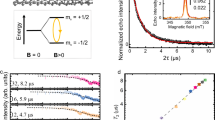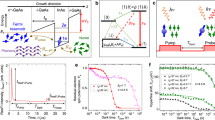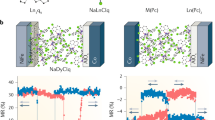Abstract
Quantum criticality is the intriguing possibility offered by the laws of quantum mechanics when the wave function of a many-particle physical system is forced to evolve continuously between two distinct, competing ground states1. This phenomenon, often related to a zero-temperature magnetic phase transition, is believed to govern many of the fascinating properties of strongly correlated systems such as heavy-fermion compounds or high-temperature superconductors1. In contrast to bulk materials with very complex electronic structures, artificial nanoscale devices could offer a new and simpler means of understanding quantum phase transitions2,3. Here we demonstrate this possibility in a single-molecule quantum dot, where a gate voltage induces a crossing of two different types of electron spin state (singlet and triplet) at zero magnetic field. The quantum dot is operated in the Kondo regime, where the electron spin on the quantum dot is partially screened by metallic electrodes. This strong electronic coupling between the quantum dot and the metallic contacts provides the strong electron correlations necessary to observe quantum critical behaviour. The quantum magnetic phase transition between two different Kondo regimes is achieved by tuning gate voltages and is fundamentally different from previously observed Kondo transitions in semiconductor and nanotube quantum dots4,5. Our work may offer new directions in terms of control and tunability for molecular spintronics6.
This is a preview of subscription content, access via your institution
Access options
Subscribe to this journal
Receive 51 print issues and online access
$199.00 per year
only $3.90 per issue
Buy this article
- Purchase on Springer Link
- Instant access to full article PDF
Prices may be subject to local taxes which are calculated during checkout




Similar content being viewed by others
References
Sachdev, S. Quantum magnetism and criticality. Nature Phys. 4, 173–185 (2008)
Vojta, M., Bulla, R. & Hofstetter, W. Quantum phase transitions in models of coupled magnetic impurities. Phys. Rev. B 65, 140405 (2002)
Hofstetter, W. & Schoeller, H. Quantum phase transition in a multilevel dot. Phys. Rev. Lett. 88, 016803 (2002)
Sasaki, S. et al. Kondo effect in an integer-spin quantum dot. Nature 405, 764–767 (2000)
Nygård, J., Cobden, D. H. & Lindelof, P. E. Kondo physics in carbon nanotubes. Nature 408, 342–346 (2000)
Bogani, L. & Wernsdorfer, W. Molecular spintronics using single-molecule magnets. Nature Mater. 7, 179–186 (2008)
Hewson, A. C. The Kondo Problem to Heavy Fermions (Cambrige Univ. Press, Cambridge, UK, 1993)
Glazman, L. I. & Raikh, M. E. Resonant Kondo transparency of a barrier with quasilocal impurity states. JETP Lett. 47, 452–455 (1988)
Goldhaber-Gordon, D. et al. Kondo effect in a single-electron transistor. Nature 391, 156–159 (1998)
Cronenwett, S. M., Oosterkamp, T. H. & Kouwenhoven, L. P. A tunable Kondo effect in quantum dots. Science 281, 540–544 (1998)
Georges, A. & Meir, Y. Electronic correlations in transport through coupled quantum dots. Phys. Rev. Lett. 82, 3508–3511 (1999)
Jones, B. A., Varma, C. M. & Wilkins, J. W. Low-temperature properties of the two-impurity Kondo hamiltonian. Phys. Rev. Lett. 61, 125–128 (1988)
Affleck, I., Ludwig, A. W. W. & Jones, B. A. Conformal-field-theory approach to the two-impurity Kondo problem: Comparison with numerical renormalization-group results. Phys. Rev. B 52, 9528–9546 (1995)
Zarand, G., Chung, C.-H., Simon, P. & Vojta, M. Quantum criticality in a double-quantum-dot system. Phys. Rev. Lett. 97, 166802 (2006)
Liang, W., Shores, M. P., Bockrath, M., Long, J. R. & Park, H. Kondo resonance in a single-molecule transistor. Nature 417, 725–729 (2002)
Park, H., Lim, A. K. L., Alivisatos, A. P., Park, J. & McEuen, P. L. Fabrication of metallic electrodes with nanometer separation by electromigration. Appl. Phys. Lett. 75, 301–303 (1999)
Park, H. et al. Nanomechanical oscillations in a single-C60 transistor. Nature 407, 57–60 (2000)
Kogan, A., Granger, G., Kastner, M. A., Goldhaber-Gordon, D. & Shtrikman, H. Singlet-triplet transition in a single-electron transistor at zero magnetic field. Phys. Rev. B 67, 113309 (2003)
Quay, C. H. L. et al. Magnetic field dependence of the spin-1/2 and spin-1 Kondo effects in a quantum dot. Phys. Rev. B 76, 245311 (2007)
Holm, J. V. et al. Gate-dependent tunneling-induced level shifts in carbon nanotube quantum dots. Preprint at 〈http://aps.arxiv.org/abs/0711.4913〉 (2007)
Paaske, J. et al. Non-equilibrium singlet-triplet Kondo effect in carbon nanotubes. Nature Phys. 2, 460–464 (2006)
Nozières, P. & Blandin, A. Kondo effect in real metals. J. Phys. (Paris) 41, 193–211 (1980)
Pustilnik, M. & Glazman, L. I. Kondo effect induced by a magnetic field. Phys. Rev. B 64, 045328 (2001)
Pustilnik, M., Avishai, Y. & Kikoin, K. Quantum dot with even number of electrons: Kondo effect in a finite magnetic field. Phys. Rev. Lett. 84, 1756–1759 (2000)
Craig, N. J. et al. Tunable nonlocal spin control in a coupled-quantum dot system. Science 304, 565–567 (2004)
Grobis, M., Rau, I. G., Potok, R. M. & Goldhaber-Gordon, D. Kondo effect in mesoscopic quantum dots, in Handbook of Magnetism and Magnetic Materials Vol. 1 (eds Kronmüller, H. & Parkin, S.) Part II (Wiley, Chichester, 2007)
Costi, T. A. Kondo effect in a magnetic field and the magnetoresistivity of Kondo alloys. Phys. Rev. Lett. 85, 1504–1507 (2000)
Potok, R. M., Rau, I. G., Shtrikman, H., Oreg, Y. & Goldhaber-Gordon, D. Observation of the two-channel Kondo effect. Nature 446, 167–171 (2006)
Hofstetter, W. & Zarand, G. Singlet-triplet transition in lateral quantum dots: A numerical renormalization group study. Phys. Rev. B 69, 235301 (2004)
Yu, L. H. & Natelson, D. The Kondo effect in C60 single-molecule transistors. Nano Lett. 4, 79–83 (2004)
Pasupathy, A. N. et al. The Kondo effect in the presence of ferromagnetism. Science 306, 86–89 (2004)
Parks, J. J. et al. Tuning the Kondo effect with a mechanically controllable break junction. Phys. Rev. Lett. 99, 026601 (2007)
Strachan, D. R. et al. Controlled fabrication of nanogaps in ambient environment for molecular electronics. Appl. Phys. Lett. 86, 043109 (2005)
Houck, A. A., Labaziewicz, J., Chan, E. K., Folk, J. A. & Chuang, I. L. Kondo effect in electromigrated gold break junctions. Nano Lett. 5, 1685–1688 (2005)
Esen, G. & Fuhrer, M. S. Temperature control of electromigration to form gold nanogap junctions. Appl. Phys. Lett. 87, 263101 (2005)
Trouwborst, M. L., van der Molen, S. J. & van Wees, B. J. The role of Joule heating in the formation of nanogaps by electromigration. J. Appl. Phys. 99, 114316 (2006)
O'Neill, K., Osorio, E. A. & van der Zant, H. S. J. Self-breaking in planar few-atom Au constrictions for nanometer-spaced electrodes. Appl. Phys. Lett. 90, 133109 (2007)
Wu, Z. M. et al. Feedback controlled electromigration in four-terminal nanojunctions. Appl. Phys. Lett. 91, 053118 (2007)
van der Zant, H. S. J. et al. Molecular three-terminal devices: fabrication and measurements. Faraday Discuss. 131, 347–356 (2006)
Acknowledgements
We acknowledge E. Eyraud and D. Lepoittevin for discussions and technical contributions regarding electronics and dilutions. We thank E. Bonet, T. Crozes and T. Fournier for lithography development, and C. Winkelmann, T. Costi and L. Calvet for discussions. The sample used in the investigations was made in the NANOFAB facility of the Néel Institut. This work is partially financed by ANR-PNANO, Contract MolSpintronics.
Author information
Authors and Affiliations
Corresponding author
Supplementary information
Supplementray Information
The file contains Supplementray Notes, Supplementray Fugures S1-S6 with Legends and additional references. The Supplementray Information includes the following parts: 1. Experimental setup ; 2. Fully-screened spin S=1/2 Kondo effect in a C60 quantum dot ; 3. Non-equilibrium singlet-triplet Kondo effect on the singlet side ; 4. Singlet-triplet transition: low versus very low temperature ; 5. Temperature dependence of the zero-bias conductance ; 6. Statistics and reproducibility of the results. (PDF 6050 kb)
Rights and permissions
About this article
Cite this article
Roch, N., Florens, S., Bouchiat, V. et al. Quantum phase transition in a single-molecule quantum dot. Nature 453, 633–637 (2008). https://doi.org/10.1038/nature06930
Received:
Accepted:
Issue Date:
DOI: https://doi.org/10.1038/nature06930
This article is cited by
-
Increasing the Hilbert space dimension using a single coupled molecular spin
Nature Communications (2021)
-
Iron phthalocyanine on Au(111) is a “non-Landau” Fermi liquid
Nature Communications (2021)
-
Evolution and universality of two-stage Kondo effect in single manganese phthalocyanine molecule transistors
Nature Communications (2021)
-
A Gd@C82 single-molecule electret
Nature Nanotechnology (2020)
-
Tunable giant magnetoresistance in a single-molecule junction
Nature Communications (2019)
Comments
By submitting a comment you agree to abide by our Terms and Community Guidelines. If you find something abusive or that does not comply with our terms or guidelines please flag it as inappropriate.



